| 1 | Common mock viper |
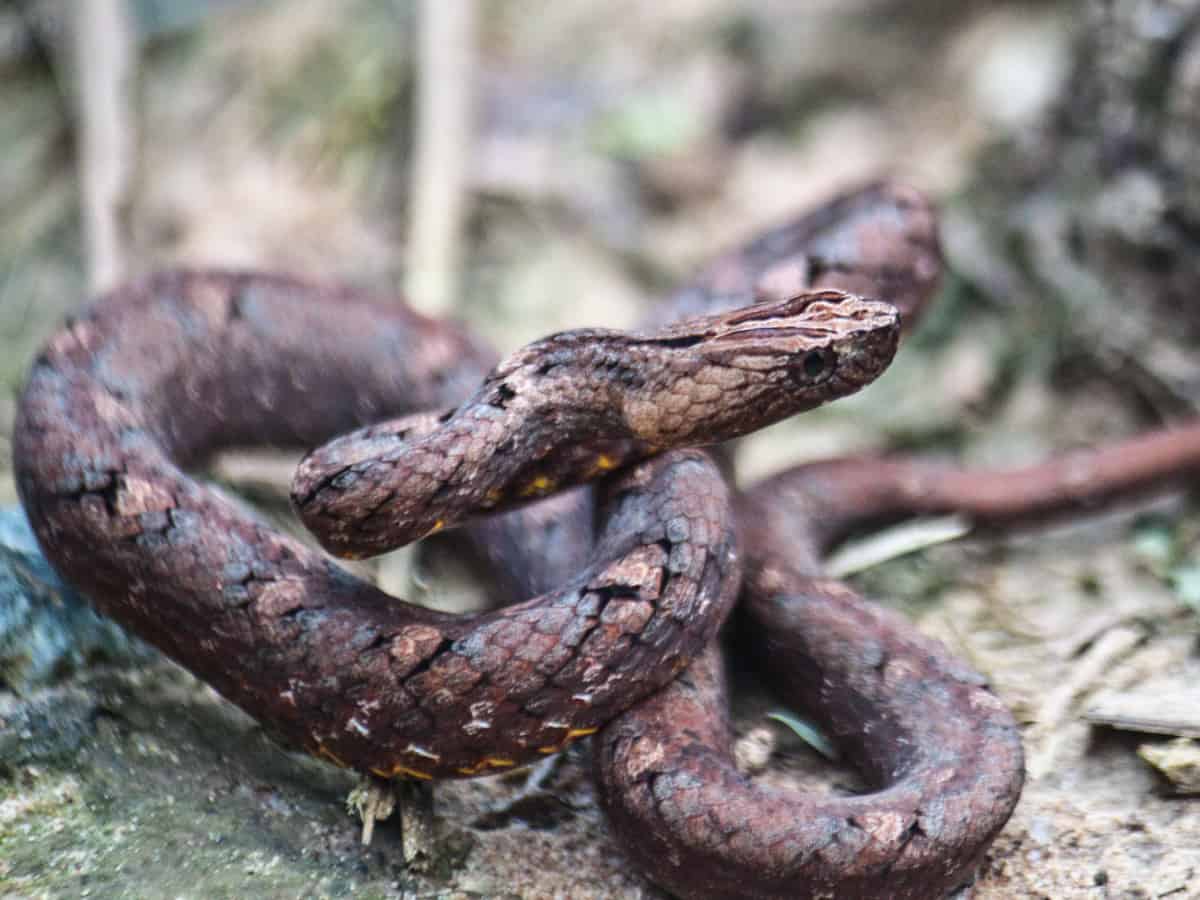
Also called Psammodynastes pulverulentus, this snake is widespread across southeast Asia, from China to Indonesia. For millions of years, it has pulled the wool over the eyes of its hungry bird neighbours, convincing them that it’s the highly toxic Malabar pitviper with a similar appearance. The Malabar pitviper has a venom LD50 rating of 1.24mg, worse than the cottonmouth or copperhead. 20% of victims develop grotesquely swollen limbs, and some die due to cerebral haemorrhages.
Malabar pitvipers are found in farmland, forests near plantations, and bamboo thickets, and so are their copycat the common mock viper. It’s mostly females that use this disguise, as the colour varies. Males are tan like dry wood, but females are brown or reddish, much closer to the Malabar pitviper. Another mimic is its bulky triangular head, a signature of the viper family.
Common mock vipers also have a bold personality, using a fake it till you make it strategy, acting like it knows its fangs are full of venom and has nothing to fear from anyone. When threatened, it will coil up and lunge forward viciously, with its eyes never breaking contact. Despite this, their bites can only cause a painful puncture.
| 2 | Turtle-headed sea snake |
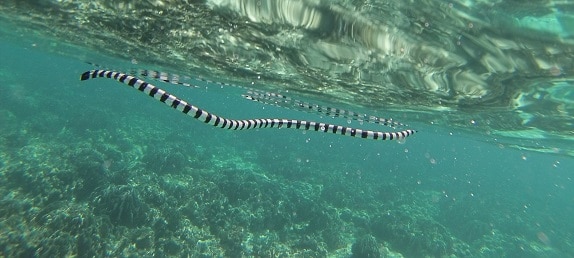
Also called Emydocephalus annulatus, this 100cm sea snake lives in Australia, from Great Barrier Reef to Shark Bay in the west. It’s a fish egg eater which moves along coral reefs slowly and grazes them like a cow, eating constant small meals rather than one massive lump.
E. annulata is sometimes found in groups, and are known for having several colour morphs. Some are nearly black, others are grey banded, but another chunk are a sharply banded black and white. This has a close resemblance to venomous sea snakes of the Laticauda family, which often live alongside them. The likes of banded sea kraits (Laticauda colubrina) have some of the most potent venom on Earth, only counteracted by the venom yield being low, whereas turtle-headed sea snake venom is extremely mild. E. annulata uses this copycat image to scare off predators such as large fish and sea eagles. In the blurriness of water, 2-5 metres deep in coral reefs, the disguise can be total.
Even scientists on expeditions sometimes mistake E. annulata for more dangerous sea snakes. Studies have found that fish flee from banded snakes in their local coral reefs, but didn’t react to purely black ones.
| 3 | Indian wolf snake |
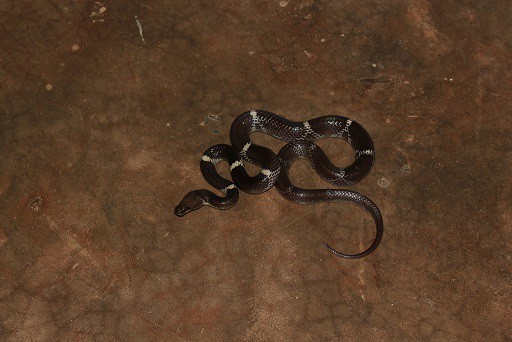
Bungarus ceylonicus is a venomous snake that lives in the forested hilly central areas of Sri Lanka. It’s a docile snake, slow and sluggish, very hesitant to strike unless the aggressor has a death wish and keeps on provoking it. However, its venom has the power to kill within 12 hours if antivenin isn’t administered, via an assault on the nervous system.
This time, the local snake to muscle in on the mimicry slot is Lycodon aulicus, AKA the Indian wolf snake. The chocolatey brown scales with very thin white bands are extremely similar, as are the body shape of thinness and a non-distinct head. In both snakes, the white bands lack razor sharp boundaries, but blend with the dark brown messily, with white sometimes visible between the brown scales.
This gives Lycodon aulicus a nice deception shield, and that’s on top it being a death-feigning snake. Lycodon aulicus even has a vicious temperament, with razor sharp teeth that rip through skin like A4 paper. This snake has every defensive trick except venom itself.
| 4 | Many spotted catsnake |
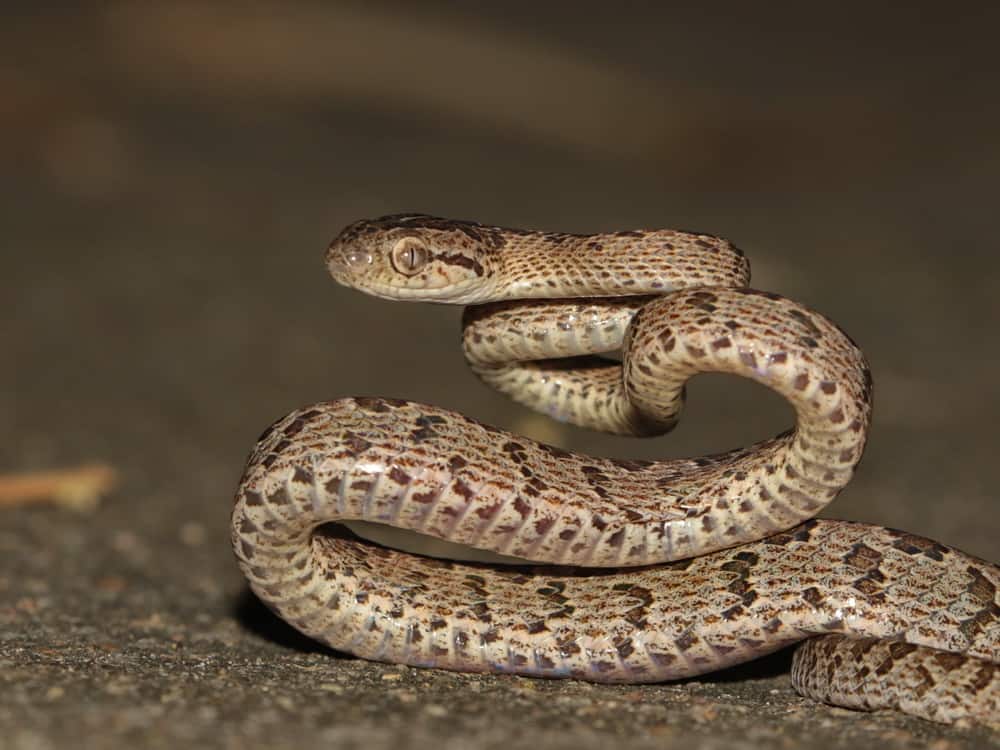
This Hong Kong snake has craftily disguised itself as the pointed-scaled pitviper, AKA habu. The latter is highly defensive, and its bites are possibly lethal. The venom contains metalloproteinases and phospholipidase A2, and one patient suffered respiratory distress as a result of tissue swelling within the lung.
Many spotted catsnakes share the habu’s brown scale base, overlaid with darker brain blotches. Their eyes are extremely similar, both with gold irises and vertical pupils. One of the only decent differences is an arrow shaped marking on the catsnake’s head which the habu lacks.
This Hong Kong snake doesn’t just rely on disguise. They keep up their end of the bargain and actually try to act like the viper, engaging in theatrics like a mock display of aggression. They coil their lower body into an shape and deliver mock lunges, and occasionally real snapping bites. This doesn’t last too long though. When they give up, they flee rapidly up a tree and stay there. The many spotted catsnake actually has venom of its own, but it’s secreted from rear fangs, and so weak and feeble that it’s never hurt anyone on record.
| 5 | Viperine water snake (Natrix maura) |
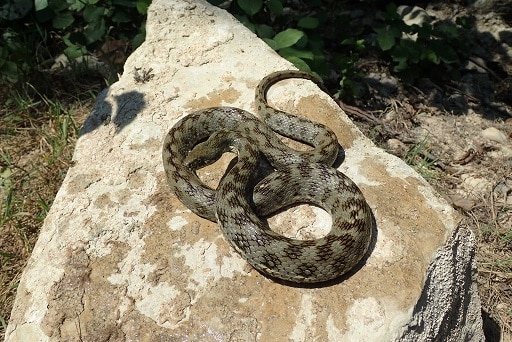
Almost anyone who sees this western European snake mistakes it for the asp viper, the most venomous snake in France. Asp vipers have an LD50 score of 1mg, which is stronger than a prairie rattlesnake. The lower venom yield is where they fall down, but they’re toxic enough to foxes, badgers, and wolf predators that natrix maura has evolved a very similar appearance, with a grey-brown base of scales overlaid with darker grey blotches.
Natrix maura is related to the grass snake (natrix natrix), and spends much time in ponds and streams. When threatened, they go through the entire repertoire of vipers: hissing, flattening its head in a triangular shape, and performing bluff strikes at the intruder with its mouth closed.
Its body is significantly thicker than a grass snake’s, and its eyes crueller, despite having no venom of its own. A 2014 study even found that the hiss had a similar acoustic frequency to vipers, making it indistinguishable for predators. The fact that it’s called the viperine water snake is an easy giveaway. This copycat snake lives in Spain, France, western Italy, and north Africa.
| 6 | Xenodon werneri |
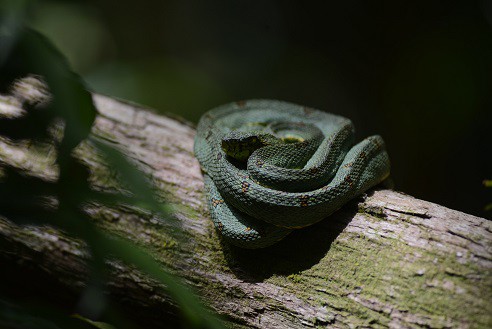
This snake just piles on layer after layer of deception. It lives in jungles and is green, so you probably won’t see it. If you do peel back some branches and stare one right in the face, you’ll probably think it’s Bothrops bilineatus and run for your life.
Xenodon werneri is a harmless snake that lives in the rainforests of French Guiana and Suriname. It’s mysterious, with little known of its diet or life cycle, but it’s maximum recorded length in females was 76cm. In males it was 62cm, and this snake is primarily green, with a creamy yellow belly. Its head is significantly wider than its neck, and each scale has a tiny black edge. All this is similar to Bothrops bilineatus, the common tree-dwelling member of the savagely venomous Bothrops family (which the lancehead also belongs to). Bothrops bilineatus venom lacks neurotoxins, melting through skin instead using cytotoxic powers, like a spilt vial of acid. In places like Leticia, Columbia, it causes the second highest amount of snakebites.
Lacking its own venom, Xenodon werneri instead shifted its appearance towards its more vicious neighbour, hoping to live a life of peace while birds leave it alone. This snake is believed to be semiaquatic, judging by the shape of its nostrils.
| 7 | Pink-headed reed snake |
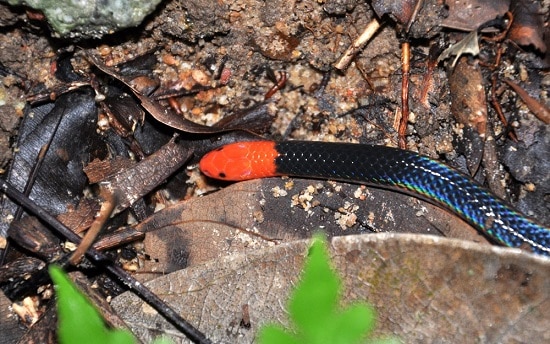
This Asian snake doubles its deception points by copying two snakes – the Malaysian blue coral snake, and the red-headed krait. Both have a bluish body with a sharply contrasting red head. Somewhere along the way, the harmless Calamaria schlegli decided that a red head was the ultimate get out of jail free card for moving through the undergrowth unscathed.
This 40cm snake lives in Singapore, Indonesia and Malaysia, lounging around in forest undergrowth, where it swallows up insects crawling past. This twiggy, branchy environment is similar to the snakes it copies. The blue coral snake has a notoriously fast venom, which once killed a man in 5 minutes. Like other coral snakes, it’s severely neurotoxic and often causes death via lung failure. The pink-headed reed snake remains unresearched, but is known to burrow for cover.
The main difference between the two is that the pink-headed reed snake lacks any red scales on its body, just blue and grey. It also has a iridescent sheen which the blue coral snake lacks.
| 8 | Rough-scaled sand boa |
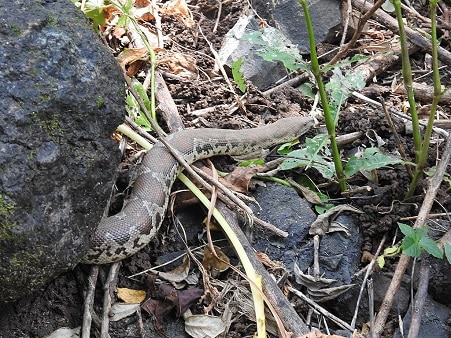
This is a thick bodied Indian snake, which burrows into sand and peeps out to ambush prey. Compared to the Arabian sand boa, they’re not as restricted to parched deserts, and might climb a tree occasionally, but they still stick to drier regions of India, skipping the moist western Ghats mountain range. Eryx conicus lacks venom, and can easily fall victim to hawks, despite their squeezing talents. Fortunately, it has disguised itself as one of India’s “big 4” snakes – the Russell’s viper.
In terms of raw fear produced worldwide, the Russell’s viper is undoubtedly near the top. It kills the most Indians, stalking farm workers and seasonally flooded rice fields. It barely moves for most of the day, but the lunging bites that explode from nowhere can be like lightning. The bite is unbelievably painful, causing rotting flesh and necessitating amputations.
If a snake was presented the option of looking like this killer, it would probably take it, but eryx conicus has done it the hard way, evolving over millions of years. Its bloated blotchy patterns bare a strong resemblance, as does the thick body, and dark eyes. Eryx conicus also plays dead on occasion.
| 9 | Eight-lined kukri snake |
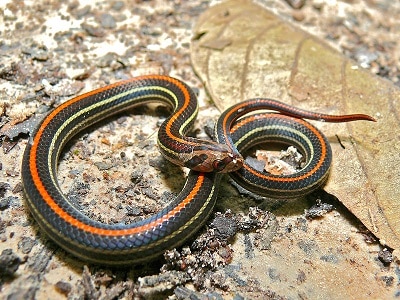
The eight-lined kukri snake (Oligodon octolineatus) resides in Malaysia, Singapore and Indonesia. Kukri snakes are named for the sharp teeth at the back of their mouth, after the Kukri knives wielded by Gurkha soldiers. However, this is a venom-less snake whose only power is to cause sharp pain. They reside in many habitats: forests, farmland, parks and gardens.
Also inhabiting these neighbourhoods is the banded coral snake (Calliophis intestinalis), a relative of the Malaysian blue coral snake. This species is shy, but deadly venomous, and renowned for venom glands that stretch down 25% of its body. Its venom primarily consists of three finger toxins which causes flaccid paralysis in its victims. Rather than overexciting neuronal connection between the muscles and frying everything (spastic paralysis), the signals decrease so that movement is impossible. Its main prey of frogs struggles to escape, before being eaten.
Over time, the ancestral eight-lined kukri snakes that resembled C. intestinalis had a survival advantage, as predators had learnt to fear them. Therefore, their genes spread, and the species become more and more similar. Both snakes have sleek, parallel red and black stripes, heads which are barely distinct from the body, and beady black eyes.
| 10 | Mexican milk snake |
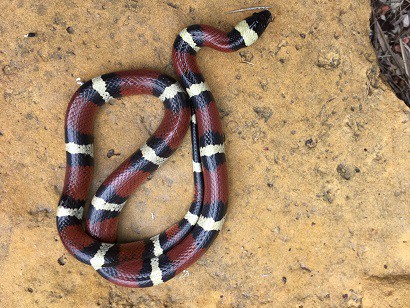
The Texas coral snake lives in western Louisiana and Arkansas, through most of Texas and into northern Mexico. It’s one of the 3 US coral snake species, and closely related to Florida’s eastern coral snake (the third is the Arizona coral snake). Its venom can supposedly kill a victim in two minutes. Texas hospitals stock North American Coral Snake Antivenin (NACSA) as a cure, and the starting dose is 5 vials. The venom is filled with neurotoxins which lead to death via lung failure, with inflating and deflating failing. Their bodies are covered with black, red and yellow stripes.
Maybe you’ve seen one of these horrors, but maybe you haven’t. The Texas coral snake has one of the most extreme lookalikes in the entire snake world – the Mexican milk snakes. These harmless snakes also inhabit northern Mexico, spilling into Texas, and are virtually indistinguishable. They’re said to be friendly and docile in captivity, relaxing and happily accepting mice chucked to them.
In the rocky, dusty wilds, this may be a disadvantage, but Mexican milk snakes are such a clone of Texas coral snakes that a bird seeing one probably does a full 180 degree reverse and flies back home.
